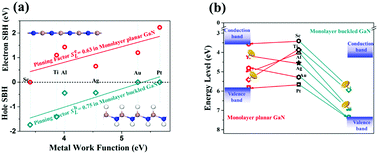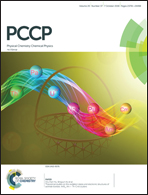n- and p-type ohmic contacts at monolayer gallium nitride–metal interfaces†
Abstract
Recently, two-dimensional (2D) gallium nitride (GaN) was experimentally fabricated, and has promising applications in next-generation electronic and optoelectronic devices. A direct contact with metals to inject the carrier is often required for potential 2D GaN devices. Herein, the first systematic study on the interface properties of monolayer (ML) planar and buckled GaN with different metal electrodes (Al, Ti, Ag, Au, Sc, and Pt) in a field-effect transistor framework is presented using first-principles energy band calculations and quantum transport simulations. Because of moderate Fermi level pinning (electron pinning factor SeL = 0.63), ML planar GaN and the Ag electrode form an n-type lateral Schottky contact, while ML planar GaN and Ti, Al, and Au electrodes form a p-type lateral Schottky contact. The ML buckled GaN, Ag, Al, Ti, and Sc electrodes form a p-type lateral Schottky contact as a result of Fermi level pinning with a hole pinning factor of ShL = 0.75. Notably, a highly desirable n-type/p-type lateral ohmic contact is formed at the lateral interface of the ML planar GaN and Sc/Pt electrodes, and a p-type lateral ohmic contact is formed at the lateral interface of the ML buckled GaN and Pt/Au electrodes. Therefore, a low resistance contact can be realized in ML planar and buckled GaN devices.



 Please wait while we load your content...
Please wait while we load your content...